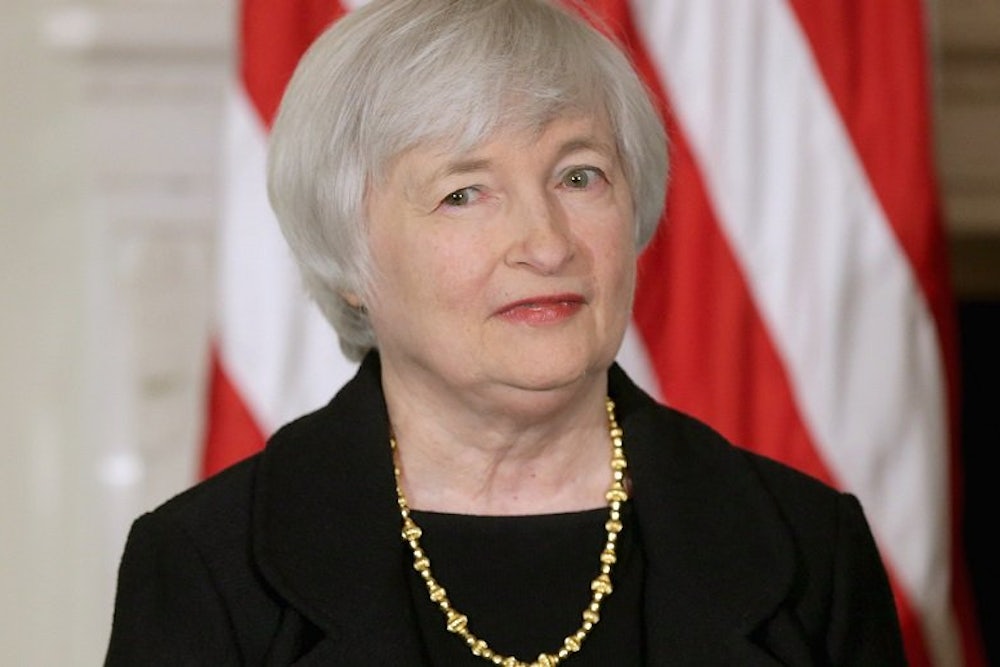On Friday morning, the Labor Department released the December jobs report and the topline numbers look like great news. The economy added 252,000 jobs last month. The November and October numbers were revised up by 32,000 and 18,000 respectively. The unemployment rate dropped to 5.6 percent.
Sounds good, right? Well there is one glaring, ominous hole: wages actually fell 0.2 percent last month. And wage growth in November, which the Labor Department originally reported was 0.4 percent, was revised down to 0.2 percent. In other words, slack in the labor market is rapidly disappearing but wages aren’t growing.
As Michelle Jamisko points out in Bloomberg, the drop in wages is partially due to the influx in seasonal workers that companies use in December for the holiday season. Those workers are generally inexperienced and paid less than full-time staff and that reduces wage growth. But the fact remains: the economy added nearly three million jobs in 2014 and yet wages grew just 1.7 percent.
The challenge for policymakers is how to change that so workers can share in the recovery. Given the disagreements between Democrats and Republicans on how to address that problem, Congress isn’t likely to pass any legislation that will help workers anytime soon, such as an increase in the minimum wage. That leaves the fate of workers in the hands of the Federal Reserve and its chair, Janet Yellen. The Fed cut rates to zero in 2009 as the financial crisis struck to encourage businesses to invest and consumers to spend money. But as the economy recovers and we near full employment, the Fed will tighten policies to prevent inflation from flaring up. In October, it ended its large-scale asset purchase program—known as quantitative easing—and it is expected to raise interest rates this summer. But given the lack of real wage growth in the economy, it’s time to rethink that timetable.
There are few signs that the recovery is putting upward pressure on inflation. The PCE price index—the Fed’s favorite measure of inflation—rose just 1.2 percent from November 2013 to November 2014, the latest available data. That understates inflation a bit, because it includes changes in oil prices, which have plummeted over the past six months. Core PCE, which excludes and energy prices and provides a more stable measure of inflation, rose 1.4 percent in the same time span. In other words, the improving economic situation hasn’t caused a corresponding increase in prices—at least not yet.
Inflation hawks are worried about the “not yet” part. They think that if the Fed does not raise rates in anticipation of inflation, inflation will rise well above the Fed’s 2 percent target. To an extent, they’re right. If the Fed waits too long, inflation will probably rise above 2 percent. But they’re wrong to be fearful of it. The fact is there is a balance between raising rates too late and inflation rising and raising them too early and prematurely choking off the recovery. As the economy continues to recover and wage growth doesn’t appear, it’s clear that economists aren’t sure where that balancing point is. The Federal Reserve, for instance, defines full employment as when the unemployment rate is around 5.3-5.5 percent. Yet, we’ve just about hit that point and wages aren’t growing. Inflation is still muted.
Here’s another thought: Maybe economists don’t actually know what the unemployment rate is at full employment—and thus don’t know when exactly to raise rates to avoid higher inflation. In 2000, for instance, the unemployment rate fell below 4 percent and inflation didn’t explode upwards. In fact, the late 1990s were the only period where average Americans have seen their wages rise over the past few decades. If we want that wage growth to return, the Federal Reserve board—and especially the inflation hawks on it—should reconsider what the economy looks like at full employment and whether we’re actually close enough to it now that it’s worth raising rates.
